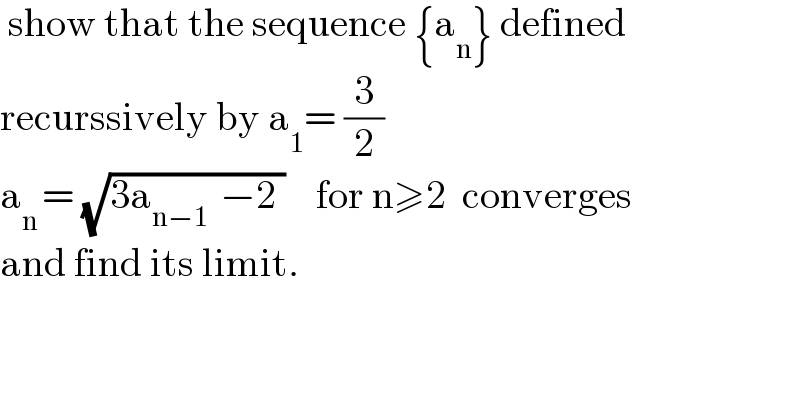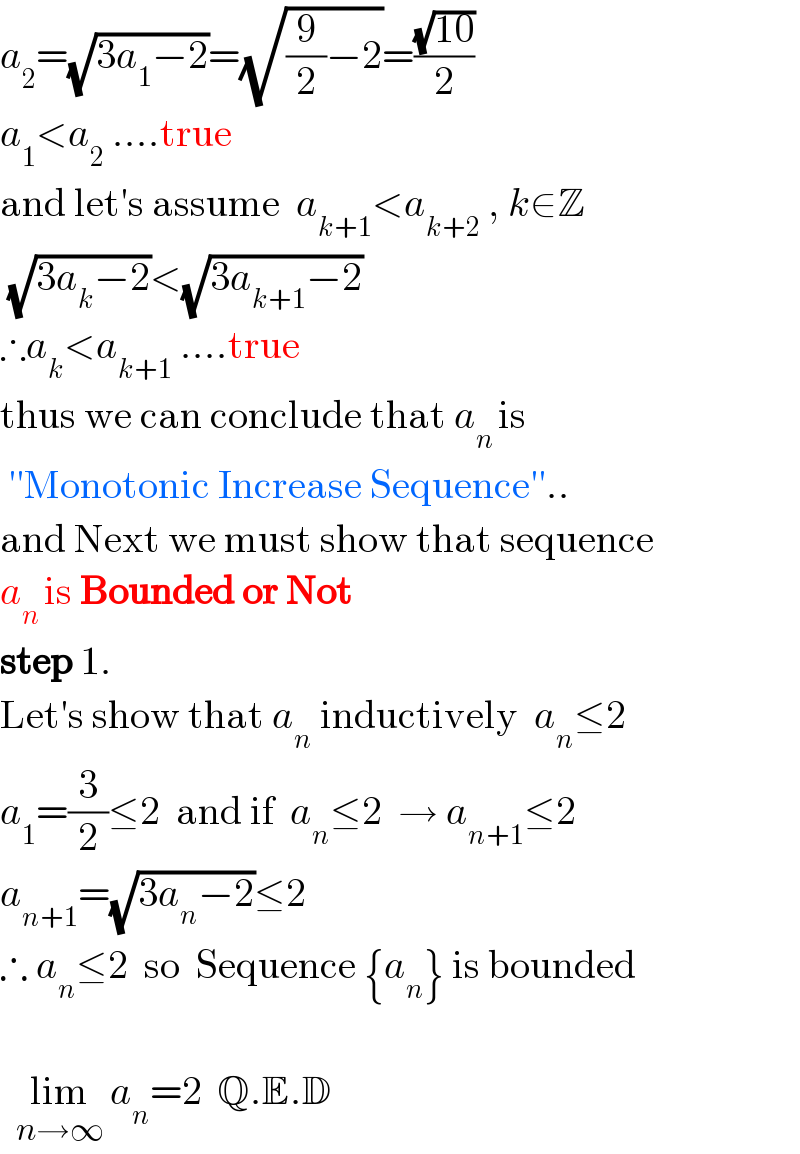
Question Number 213468 by universe last updated on 06/Nov/24

$$\:\mathrm{show}\:\mathrm{that}\:\mathrm{the}\:\mathrm{sequence}\:\left\{\mathrm{a}_{\mathrm{n}} \right\}\:\mathrm{defined}\: \\ $$$$\mathrm{recurssively}\:\mathrm{by}\:\mathrm{a}_{\mathrm{1}} =\:\frac{\mathrm{3}}{\mathrm{2}} \\ $$$$\mathrm{a}_{\mathrm{n}\:} =\:\sqrt{\mathrm{3a}_{\mathrm{n}−\mathrm{1}\:} \:−\mathrm{2}\:}\:\:\:\:\mathrm{for}\:\mathrm{n}\geqslant\mathrm{2}\:\:\mathrm{converges}\: \\ $$$$\mathrm{and}\:\mathrm{find}\:\mathrm{its}\:\mathrm{limit}. \\ $$
Answered by issac last updated on 06/Nov/24

$${a}_{\mathrm{2}} =\sqrt{\mathrm{3}{a}_{\mathrm{1}} −\mathrm{2}}=\sqrt{\frac{\mathrm{9}}{\mathrm{2}}−\mathrm{2}}=\frac{\sqrt{\mathrm{10}}}{\mathrm{2}} \\ $$$${a}_{\mathrm{1}} <{a}_{\mathrm{2}} \:....\mathrm{true} \\ $$$$\mathrm{and}\:\mathrm{let}'\mathrm{s}\:\mathrm{assume}\:\:{a}_{{k}+\mathrm{1}} <{a}_{{k}+\mathrm{2}} \:,\:{k}\in\mathbb{Z} \\ $$$$\:\sqrt{\mathrm{3}{a}_{{k}} −\mathrm{2}}<\sqrt{\mathrm{3}{a}_{{k}+\mathrm{1}} −\mathrm{2}} \\ $$$$\therefore{a}_{{k}} <{a}_{{k}+\mathrm{1}} \:....\mathrm{true} \\ $$$$\mathrm{thus}\:\mathrm{we}\:\mathrm{can}\:\mathrm{conclude}\:\mathrm{that}\:{a}_{{n}\:} \mathrm{is} \\ $$$$\:''\mathrm{Monotonic}\:\mathrm{Increase}\:\mathrm{Sequence}''.. \\ $$$$\mathrm{and}\:\mathrm{Next}\:\mathrm{we}\:\mathrm{must}\:\mathrm{show}\:\mathrm{that}\:\mathrm{sequence} \\ $$$${a}_{{n}\:} \mathrm{is}\:\boldsymbol{\mathrm{Bounded}}\:\boldsymbol{\mathrm{or}}\:\boldsymbol{\mathrm{Not}} \\ $$$$\boldsymbol{\mathrm{step}}\:\mathrm{1}. \\ $$$$\mathrm{Let}'\mathrm{s}\:\mathrm{show}\:\mathrm{that}\:{a}_{{n}} \:\mathrm{inductively}\:\:{a}_{{n}} \leq\mathrm{2} \\ $$$${a}_{\mathrm{1}} =\frac{\mathrm{3}}{\mathrm{2}}\leq\mathrm{2}\:\:\mathrm{and}\:\mathrm{if}\:\:{a}_{{n}} \leq\mathrm{2}\:\:\rightarrow\:{a}_{{n}+\mathrm{1}} \leq\mathrm{2} \\ $$$${a}_{{n}+\mathrm{1}} =\sqrt{\mathrm{3}{a}_{{n}} −\mathrm{2}}\leq\mathrm{2} \\ $$$$\therefore\:{a}_{{n}} \leq\mathrm{2}\:\:\mathrm{so}\:\:\mathrm{Sequence}\:\left\{{a}_{{n}} \right\}\:\mathrm{is}\:\mathrm{bounded} \\ $$$$\:\: \\ $$$$\:\:\underset{{n}\rightarrow\infty} {\mathrm{lim}}\:{a}_{{n}} =\mathrm{2}\:\:\mathbb{Q}.\mathbb{E}.\mathbb{D} \\ $$
